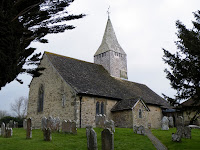 Entering a church in medieval times would have been a huge shock. The natural wood, stone and white plaster we are used to would have been covered in a riot of paintwork.
Entering a church in medieval times would have been a huge shock. The natural wood, stone and white plaster we are used to would have been covered in a riot of paintwork. Pictures of the life of Christ and the saints in painted architecture would have covered every inch of the walls and often the ceiling too. The outlines of the aisle arches and windows were accentuated by jazzy zigzag ornament, bands of formal foliage ran along the tops of the walls and stenciled flowers and leaves dotted any space too small or awkward for anything larger. The effect would have been overwhelming and, to modern eyes, more than a little vulgar.
Cathedrals were painted on the outside too, which must have transformed them into beacons in a drab world.
Almost all of this great art was either whitewashed over or completely destroyed at the Reformation, as were the paintings at St Mary in West Chiltington. They lay concealed until 1882.
The scheme is unusually comprehensive, covering all the walls of the nave and aisle.
The oldest paintings are simple geometrical patterns probably dating back to the 12th century, when the south aisle was built. A circular medallion is a cross in the form of an endless rope, a motif that is found in mosaic form at Fishbourne Roman Palace.
The paintings in the nave date from the 13th century. The pictures on the south wall show the Passion, from the Entry into Jerusalem to the Angel at the Tomb. Each scene is framed in a painted niche, with columns and trefoil arches.
The north wall has scenes from the Nativity on two levels, starting with the Annunciation. It also includes a curious figure of Christ standing amid the tools of labour including shears, a cleaver, a square, a weaver's shuttle and a cartwheel. Also shown is a pair of dice. The picture is apparently a warning not to work (or, presumably, gamble) on the Sabbath.
 The chancel wall would probably have had a picture of the Second Coming, with graphic images of the souls of the damned being dragged into hell, but nothing of this survives except a small figure of an angel playing a fiddle, which is no longer in its original place.
The chancel wall would probably have had a picture of the Second Coming, with graphic images of the souls of the damned being dragged into hell, but nothing of this survives except a small figure of an angel playing a fiddle, which is no longer in its original place.


